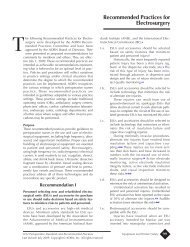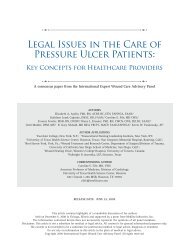2009 CAUTI guidelines - Centers for Disease Control and Prevention
2009 CAUTI guidelines - Centers for Disease Control and Prevention
2009 CAUTI guidelines - Centers for Disease Control and Prevention
You also want an ePaper? Increase the reach of your titles
YUMPU automatically turns print PDFs into web optimized ePapers that Google loves.
studies. 3,25,260-276 The findings of the evidence review <strong>and</strong> the grades <strong>for</strong> all important outcomesare shown in Evidence Review Table 2D.Q2D.1. Multifaceted infection control/quality improvement programsLow-quality evidence suggested a benefit of multifaceted infection control/quality improvementprograms to reduce the risk of <strong>CAUTI</strong>. 3,260-267 This was based on a decreased risk of SUTI,bacteriuria/unspecified UTI, <strong>and</strong> duration of catheter use with implementation of such programs.Studies evaluated various multifaceted interventions. The studies with significant findingsincluded: 1) education <strong>and</strong> per<strong>for</strong>mance feedback regarding compliance with catheter care,emphasizing h<strong>and</strong> hygiene, <strong>and</strong> maintaining unobstructed urine flow; 2) computerized alerts tophysicians, nurse-driven protocols to remove catheters, <strong>and</strong> use of h<strong>and</strong>held bladder scannersto assess <strong>for</strong> urinary retention; 3) <strong>guidelines</strong> <strong>and</strong> education focusing on perioperative cathetermanagement; <strong>and</strong> 4) a multifaceted infection control program including <strong>guidelines</strong> <strong>for</strong> catheterinsertion <strong>and</strong> maintenance. A program using a checklist <strong>and</strong> algorithm <strong>for</strong> appropriate catheteruse also suggested a decrease in unspecified UTI <strong>and</strong> catheter duration, but statisticaldifferences were not reported.Q2D.2. RemindersVery low-quality evidence suggested a benefit of using urinary catheter reminders to prevent<strong>CAUTI</strong>. 268-270 This was based on a decreased risk of bacteriuria <strong>and</strong> duration of catheterization<strong>and</strong> no differences in recatheterization or SUTI when reminders were used. Reminders tophysicians included both computerized <strong>and</strong> non-computerized alerts about the presence ofurinary catheters <strong>and</strong> the need to remove unnecessary catheters.Q2D.3. Bacteriologic monitoringVery low-quality evidence suggested no benefit of bacteriologic monitoring to prevent<strong>CAUTI</strong>. 25,271 Although one study found a decreased risk of bacteriuria during a period ofbacteriologic monitoring <strong>and</strong> feedback, only 2% of SUTI episodes were considered potentiallypreventable with the use of bacteriologic monitoring.Q2D.4. H<strong>and</strong> hygieneVery low-quality evidence suggested a benefit of using alcohol h<strong>and</strong> sanitizer in reducing<strong>CAUTI</strong>. This was based on one study in a rehabilitation facility that found a decrease inunspecified UTI, although no statistical differences were reported. 272 A separate multifacetedstudy that included education <strong>and</strong> per<strong>for</strong>mance feedback on compliance with catheter care <strong>and</strong>h<strong>and</strong> hygiene showed a decrease in risk of SUTI. 265Q2D.5. Patient placementVery low-quality evidence suggested a benefit of spatially separating patients to preventtransmission of urinary pathogens. 273 This was based on a decreased risk of transmission ofurinary bacterial pathogens in nursing home residents in separate rooms compared to residentsin the same rooms.Q2D.6. Catheter team versus self-catheterization46
















